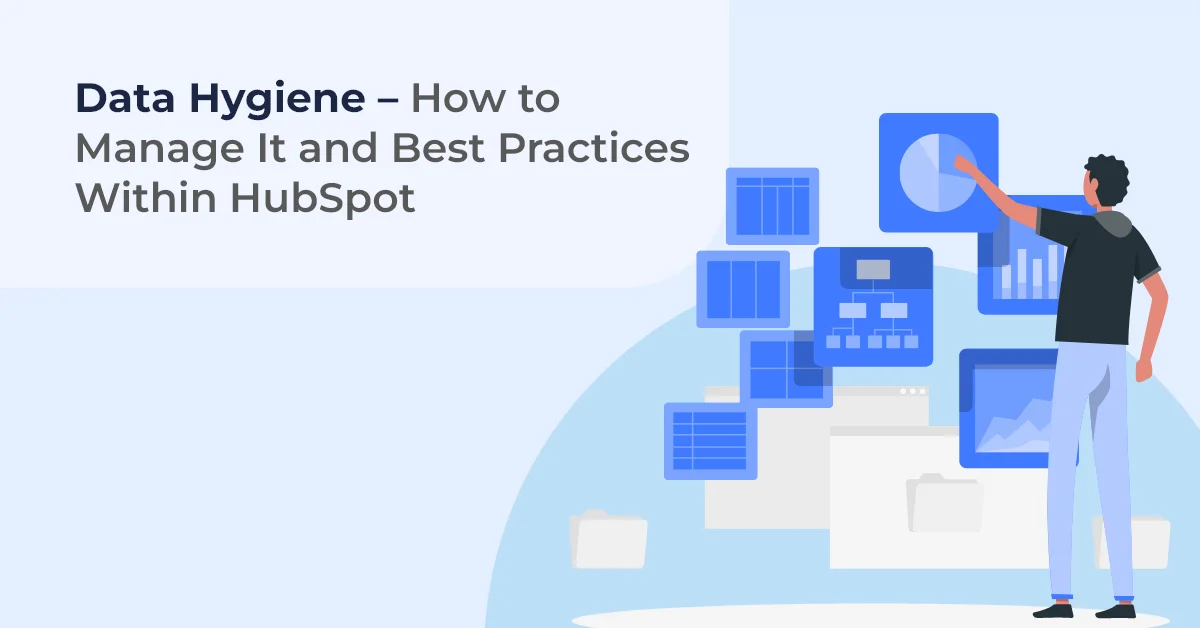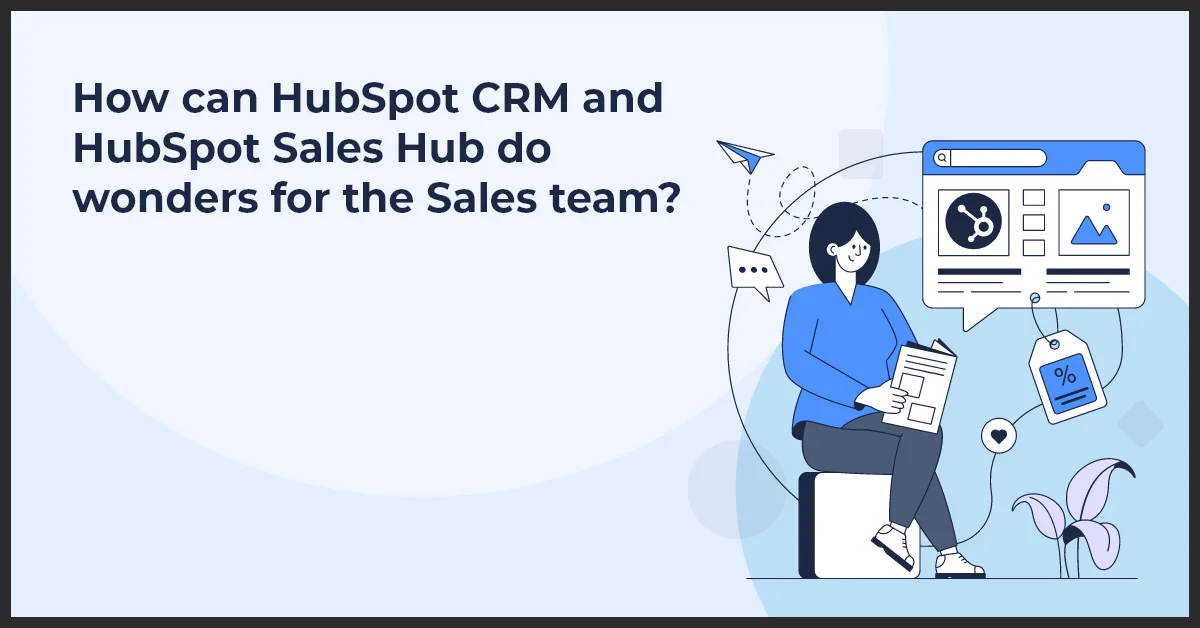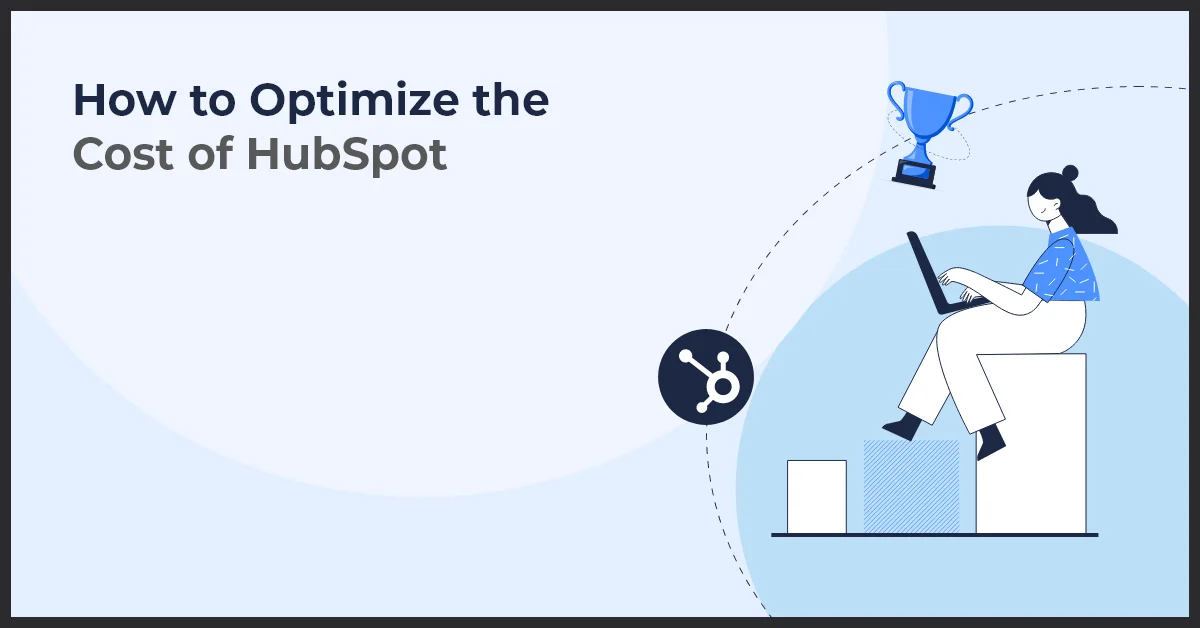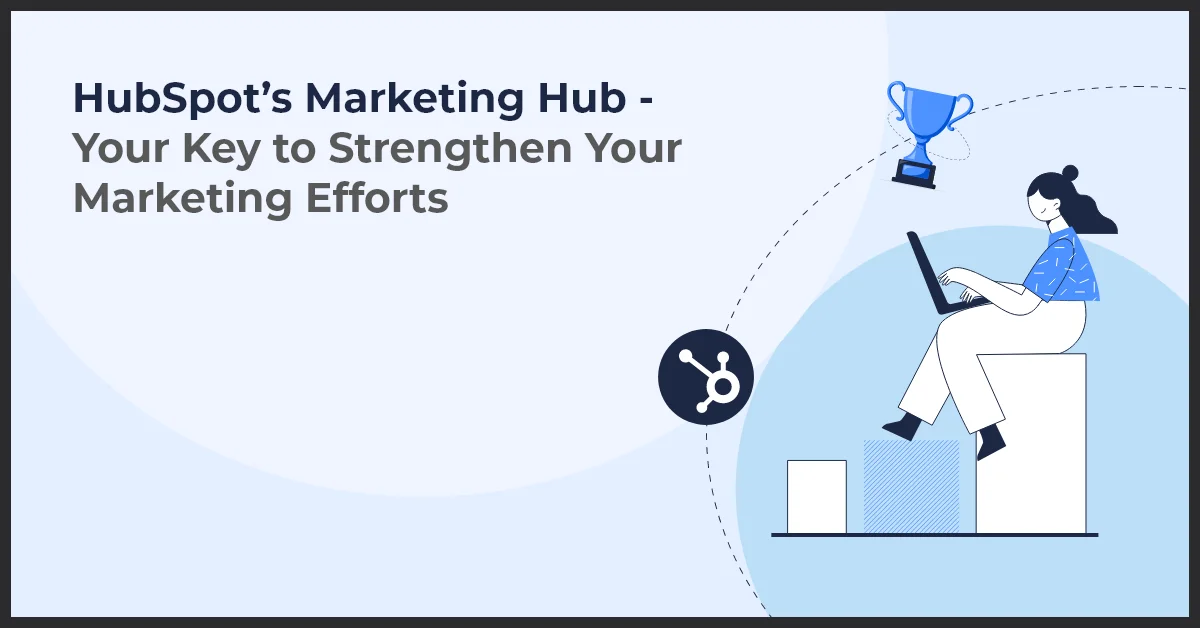Data Hygiene – How to Manage It and Best Practices Within HubSpot

Published on: July 18, 2022
Updated on: October 15, 2024
2169 Views
- HubSpot
17 min read
Did you know bad data results in sales and marketing teams losing 546 hours annually? If that doesn’t sound startling enough, according to IBM, businesses in the United States lose more than $3 trillion annually in missed opportunities due to bad data. In today’s world of business where data is one of the key inputs, collecting tons of data alone won’t ensure success. It is the quality of the data that acts as the market differentiator.
Unused email addresses, duplicate contacts, old phone numbers, and misspelled names can spell doom for your marketing efforts. These clutter your CRM and throw your marketing efforts off track. As much as your organization focuses on capturing data, you must replicate the same efforts toward cleaning data. However, it is important to adopt and implement the best practices of data hygiene to clean your CRM and retain your competitive edge
Wait, What Is Data Hygiene?
In simple words, data hygiene refers to the process of cleaning your database and optimizing it to ensure that the customer information is accurate, up-to-date, and devoid of any errors. Your organization must implement good data hygiene as this improves the productivity of sales and marketing teams.
Why Is Data Hygiene Essential?
The quality of your database plays an important role in your organization’s day-to-day decision-making. When your team has access to the most recent files and documents free of errors, it improves efficiency in the organization. Apart from this, there are other reasons why data hygiene is important and why your organization must take it seriously.
1. Improves Targeted Marketing
The success of your marketing campaigns rests on precise targeting. When you reach out to people with an apt message at the right time, it ensures higher conversions and adds to your brand equity. The quality and accuracy of your database sit at the heart of targeted marketing.
Qualified leads can increase conversions, shorten the sales cycle, and lower customer acquisition costs. As the amount of data being created and captured moves northward in the coming years, the importance of data hygiene in targeted marketing shall also grow correspondingly.
2. Promotes Efficient Marketing
Erroneous data not only reduces the conversion rates but in the worst cases, can jeopardize your marketing campaign. Outdated data can make your sales and marketing team approach the wrong customers and lead to a waste of marketing resources.
According to a Gartner study, businesses lose $15 million per year in marketing campaigns due to poor-quality data. These losses will widen in the coming years as businesses’ reliance on data increases and the information environment becomes complex. Investing in data hygiene will thus help improve the efficiency of your marketing campaigns.
3. Reduces Compliance Risks
Over the last few years, we have seen several legislations dealing with privacy and data security being passed. From the European Union’s GDPR to California’s CCPA and the United Kingdom’s Data Protection Act, all these laws increased compliance risks for organizations, especially small and medium businesses that did not have stringent data handling protocols.
Data hygiene ensures compliance with these legislations as it refines the process of data collection and handling. In an interconnected world where businesses function across geographies, improving the process of capturing and handling data mitigates the risk of compliance and legislation.
4. Ensures Data Consistency
Large organizations often struggle with data consistency and the quality of their data. Poor quality data and lack of consistency negate the primary purpose of collecting data—to convert information into meaningful insights. Often different teams in the organization collect data through different channels which can lead to a lack of consistency.
By implementing data hygiene, you can ensure that different teams interacting with customers are using the same set of data. It prevents repetitive calls to customers or bugs them with irrelevant questions. In the process, you will be able to improve customer satisfaction and encourage customer loyalty.
5. Improves Decision-Making
Business decisions are increasingly data-driven, and they are likely to become more so in the future. Though data analytics helps in identifying opportunities and recognizing threats, it is imperative to say the quality of data can make or break your decision-making process.
Data hygiene offers your decision-makers access to correct and up-to-date information. From historical insights to market forecasts, they can get access to all relevant information. Organizations that leverage artificial intelligence and machine learning can also largely benefit from clean data.
Pro Tip: Regularly audit and clean your database to eliminate outdated, duplicate, or incorrect information—this boosts accuracy and ensures better decision-making.
Common Data Hygiene Challenges
Ensuring the cleanliness and accuracy of data is a crucial aspect of maintaining a successful database. However, numerous challenges can arise when it comes to data hygiene, putting the effectiveness of your operations at risk.
Let's explore some of the common data hygiene challenges:
A. Identifying dirty data in databases
One of the primary hurdles in maintaining data hygiene is identifying dirty data within your databases. Dirty data refers to inaccurate, incomplete, or duplicated information that can corrupt the overall quality of your database. It can be a daunting task to manually pinpoint these issues, especially if you have a large volume of data.
B. Consequences of ignoring data hygiene practices
Ignoring data hygiene practices can have severe consequences for your business. When you neglect to clean and update your data regularly, it can lead to inefficient decision-making, erroneous analysis, and wasted resources. Moreover, it can damage your reputation and hinder your ability to provide personalized experiences to your customers.
C. Typical issues resulting from poor data hygiene
Poor data hygiene can cause a range of issues that can adversely affect your business operations.
Some common issues resulting from poor data hygiene include:
- Outdated contact information, leading to ineffective communication with customers
- Inaccurate customer preferences, resulting in irrelevant marketing campaigns
- Duplicate records lead to confusion, wasted resources, and skewed analytics
- Incomplete data, hindering segmentation and personalization efforts
Addressing these typical issues requires implementing robust data hygiene practices and adopting the right tools and technologies to maintain data accuracy and cleanliness.
Pro Tip: Regularly schedule data audits to identify and resolve issues like outdated, duplicate, or incomplete records. Use automated tools for efficient data hygiene maintenance, ensuring accurate, actionable insights and improved customer interactions. Clean data is key to successful, data-driven decisions.
Data Hygiene Best Practices
Data hygiene is crucial for maintaining clean and accurate data. By following these best practices, you can ensure the quality and integrity of your data:
A. Data Quality Management
- Understanding the importance of data quality in maintaining clean data: Recognize that high-quality data is essential for making informed business decisions and achieving desired outcomes.
- Implementing data quality policies and procedures: Define and enforce standards, guidelines, and processes to ensure consistent data quality across the organization.
- Strategies for continuous data quality improvement: Regularly monitor, assess, and enhance data quality by establishing feedback loops and implementing corrective measures.
B. Data Cleansing Techniques
- Exploring various data cleansing methods: Familiarize yourself with techniques such as deduplication, standardization, parsing, and validation to identify and eliminate duplicate or inaccurate data.
- Identifying and removing duplicate or inaccurate data: Utilize automated tools and manual review processes to detect and remove duplicate entries or erroneous information.
- Addressing inconsistencies and errors in data: Analyze data for inconsistencies, errors, and missing values, and take appropriate actions to correct or fill in the gaps.
C. Data Validation Methods
- Importance of data validation in ensuring data accuracy: Validate data at different stages, such as data entry, integration, and migration, to identify and correct errors or discrepancies.
- Best practices for validating data at various stages: Implement validation rules, data integrity checks, and exception handling processes to prevent the inclusion of faulty or incomplete data.
- Implementing validation rules and processes: Define and enforce data validation rules and procedures to maintain consistent and reliable data.
D. Data Integrity Strategies
- Understanding data integrity and its significance: Recognize the importance of maintaining the accuracy, consistency, and reliability of data throughout its lifecycle.
- Techniques for maintaining and preserving data integrity: Utilize measures such as data backups, version control, and access controls to prevent data corruption, unauthorized modifications, or loss.
- Implementing data integrity checks and controls: Regularly audit and verify data integrity through data validation, reconciliations, and data governance practices.
E. Data Standardization and Normalization
- Explaining the importance of standardization for clean data: Standardize data formats, fields, and structures to ensure consistency and comparability across different datasets.
- Best practices for standardizing data formats and structures: Establish data dictionaries, templates, and guidelines to promote standardized data entry, storage, and exchange.
- Normalization techniques to eliminate redundant data: Break down data into atomic units and eliminate redundant information to reduce data duplication and improve data efficiency.
F. Data Governance and Stewardship
- Establishing data governance practices for better data hygiene: Define policies, processes, and responsibilities for managing data assets, ensuring data quality, and maintaining data privacy and security.
- Defining roles and responsibilities for data stewardship: Appoint data stewards who are accountable for data quality, data access, and data handling within their respective domains.
- Strategies for ensuring data governance compliance and accountability: Implement regular audits, training programs, and data governance frameworks to ensure adherence to data hygiene best practices.
G. Data Privacy and Security Practices
- Importance of protecting customer and business information: Safeguard sensitive data from unauthorized access, breaches, or misuse to maintain trust, comply with regulations, and mitigate risks.
- Implementing data privacy practices for secure databases: Employ encryption, access controls, secure networks, and data anonymization techniques to protect data privacy.
- Overview of data security measures and compliance requirements: Stay updated with data security best practices and comply with relevant regulations, such as GDPR, CCPA, or HIPAA.
H. Data Deduplication and Record Matching
- Techniques for identifying and removing duplicate records: Utilize matching algorithms, fuzzy logic, or similarity measures to identify and merge duplicate records within your databases.
- Establishing record-matching algorithms and strategies: Define rules and criteria for matching records and resolving conflicts to ensure accurate and consolidated data.
- Implementing data deduplication processes for clean databases: Regularly run deduplication routines and maintain unique identifiers to prevent the accumulation of duplicate data.
Data Enrichment and Augmentation
In order to ensure data accuracy and completeness, it is essential to explore methods for data enrichment and augmentation. By enhancing existing data and utilizing external data sources, organizations can improve the overall quality and value of their data.
1. Exploring methods to enhance data accuracy and completeness
To enhance data accuracy and completeness, organizations can implement various methods.
These methods include:
- Regularly validating and verifying data
- Standardizing data formats and structures
- Eliminating duplicate or redundant data
- Applying data cleansing techniques
By implementing these methods, organizations can ensure that their data is accurate, up-to-date, and free from errors.
2. Utilizing external data sources for data enrichment
In addition to enhancing existing data, organizations can also leverage external data sources for data enrichment. These sources can provide additional information, such as demographic data, market trends, or customer preferences.
By integrating external data sources into their existing data, organizations can gain deeper insights and better understand their target audience. This can help in making informed business decisions and developing more personalized marketing strategies.
3. Strategies for effectively augmenting existing data
Augmenting existing data involves enhancing it with additional relevant information.
Some strategies for effectively augmenting existing data include:
- Using data enrichment services or tools
- Employing data mining techniques
- Utilizing machine learning algorithms
- Incorporating social media data
- Collecting customer feedback and preferences
By augmenting existing data, organizations can enrich their understanding of their customer base and tailor their products or services accordingly.
Data cleaning is a process that takes you through different phases which we are going to look at now.
Phases for Cleaning Up Your HubSpot CRM Data
When you decide to clean your database, you must segregate this process into five phases:
1. Start With a Comprehensive Audit
The process starts with a comprehensive audit. Before you start fixing the system, it is important to identify the loopholes and plan out the process of correcting them.
In the audit phase, you need to go deep into the database to understand how your business is using the data and data points that are crucial to your business process. At this stage, you will be able to identify obsolete or irrelevant data that you can remove to make your database leaner and more relevant.
2. Focus on Details
Here your focus should be on the details. This is important as the smallest inconsistencies can blow up into major limitations for your sales and marketing efforts. Removing such inconsistencies at this stage will save you from the efforts of standardizing your data as you go along.
When you focus on the smallest details in the database, you are likely to come across repetitive errors. Altering the data collection process or changing how data is managed can help improve your data quality.
3. Standardize Your Data
Standardization is the most important step in your data cleansing efforts. Organizations that collect data from multiple channels tend to face the challenge of data inconsistency. It can grow over time and become an unmanageable problem. Thankfully, HubSpot makes it easy to standardize your data. Let us focus on a few areas where standardization can improve the quality of your database.
a. Numbers & Abbreviations
Numbers and abbreviations are widely used in form filling. While abbreviations such as CEO or CFO may be common, there are instances when a content marketing manager and a chief marketing manager might use the same abbreviation. Similarly, a 10-digit phone number might be entered in multiple ways such as 1231231234, 123-123-1234, or (123)-123-1234. Thus, you need to set rules that standardize information and improve the quality of your database.
b. Email Standardization & Verification
The same goes for email where you must set rules for IDs to be entered in the format of abc@domain.com instead of practices such as name[at]domaindotcom or name[at]domain.com, etc. Similarly, you must ensure that the user doesn’t leave empty spaces in emails.
It is equally important to verify all email IDs. Entering fake email addresses is as old as form-filling itself! Having a large number of fake email IDs in your database hurts its quality.
c. Mailing Addresses
Standardize mailing addresses where you set rules for states, zip codes, street addresses, etc. This improves the quality of the database and ensures that documents mailed to the addresses reach their destinations.
4. Removing Unnecessary Information
To ensure seamless access to data and accurate search, it is important to remove whitespaces and unwanted characters. A simple glance into your database and you will come across both of these issues.
Extra whitespace is a common error in data collection, but it can lead to formatting and usability issues. Similarly, unwanted characters also get entered during the encoding process. Though organizations tend to overlook this issue, fixing this problem and improving the quality of your data have a big impact on your sales and marketing process.
5. Maintaining Uniformity
Data cleaning is not the end goal but maintaining a clean and healthy database is. Hence, it is important to maintain uniformity in the database which can be achieved by defining and implementing standard processes that are religiously followed in the organization. This helps your organization when the database grows in the future.
There are three important things to focus on here – the way the data is collected, the error resolution process, and a protocol to deal with unwanted and bad data.
How to Maintain a Clean CRM
Now that you know the importance of data hygiene and how to clean up your HubSpot CRM data, we turn our attention to maintaining a clean CRM. Here are some of the best practices that you should implement in your organization to achieve a clean CRM.
1. Assign CRM Cleaning Roles
Start with a consistent approach to data cleaning. While some organizations have dedicated teams and CRM managers to implement data hygiene, others delegate this job to individual team members. Irrespective of the path your organization opts for, it is important to establish a consistent process where the tasks are clearly defined for the CRM managers or individual team members.
2. Setup A CRM Cleaning Schedule
It is important to establish a CRM cleaning schedule and not leave it to discretion. Depending on the volume of data your organization is collecting, you should have a monthly, quarterly, or annual schedule.
Scheduling does away with the ambiguity in the process and lets your organization override the challenges whenever a new dataset is created. Irrespective of the size of the organization, it is important that this process is consistent and not impulsive.
3. Streamline Data Collection
The root cause of bad and inaccurate data is your data collection process and streamlining it can simplify data cleaning for you. Standardize the input process where you set up accurate fields, especially for the CRM data that you collect manually.
4. Standardize Data
Focus on data standardization as this makes the sales process effective and efficient. Whether it is the first and last name of individuals or restriction to the use of special characters, you must set up a standard form for data collection across different channels with clearly marked mandatory fields. Standardize the phone numbers field to make them compatible with the system.
5. Leverage HubSpot Integrations
HubSpot’s data management integrations can make data collection a cakewalk and ease the data cleaning process later.
Take advantage of integrations such as ZoomInfo, Leadspace, Insycle Data Management, and Dynamics by SyncSmart to make data management efficient.
6. Update Contact Lifecycle Stages
It is important to distinguish between a lead and a customer. By creating HubSpot’s Lifecycle Stage Update Workflow, you will be able to achieve this. It will allow your sales and marketing teams to understand the nature of the contact and dedicate the right resources to that end.
7. Remove Unwanted Data
Once you have collected data, you need to remove unwanted or unused contact properties. You can easily achieve this by creating a workflow in the HubSpot portal. You also need to remove any unused templates and documents, which will prevent any unwanted information from distracting your team and help standardize the database.
Key Takeaways
- Poor data quality can lead to significant business losses, including missed opportunities and wasted marketing efforts.
- Integration with HubSpot CRM allows seamless management of content, customer data, and marketing campaigns in one platform.
- Data hygiene is essential for keeping databases accurate, up-to-date, and free from errors, improving the efficiency of marketing and sales teams.
- Maintaining clean data supports targeted marketing, reduces compliance risks, and ensures data consistency across an organization.
- Implementing best practices like data validation, deduplication, and standardization helps address common challenges in maintaining data hygiene.
- A thorough audit, attention to detail, and standardized data collection processes can significantly improve data quality and business performance.
- Maintaining clean and accurate data consistently is critical for driving better decision-making and improving customer satisfaction.
Final Thoughts
You cannot avoid bad or inconsistent data when your organization collects data from multiple sources. However, implementing data hygiene across the board helps improve the quality and reliability of data and turn it into a treasure trove of insights for faster and better decisions.
There is no magic bullet to maintaining a clean HubSpot CRM; it is a culture that you must implement across the board. By following the steps mentioned above, your organization will be able to maintain a clean and up-to-date database that improves efficiency and conversions while at the same time, shortens the sales cycle.
Data cleaning and data hygiene implementation is a complex process and requires expert intervention. If you are looking for a team of motivated data scientists, Growth Natives is at your service. We are a HubSpot Platinum Solutions partner and have a large team of data experts who can implement best practices to help your organization grow. Shoot an email at info@growthnatives.com or visit our website to book a free consultation.
Sources:-
Frequently Asked Questions
Data quality refers to the accuracy, completeness, and reliability of data. In contrast, data hygiene focuses on maintaining clean and up-to-date data through regular cleansing processes like removing duplicates, fixing errors, and standardizing formats.
Clean data improves reporting accuracy, enhances segmentation, increases email deliverability, boosts personalization in marketing, and enables better decision-making by providing a clear and reliable customer view.
Key steps include regularly cleaning and updating data, removing duplicates, correcting inaccuracies, standardizing data formats, validating data sources, and implementing automated processes for ongoing maintenance.
Poor data hygiene leads to inaccurate reporting, skewed metrics, flawed segmentation, ineffective marketing efforts, and potential loss of business opportunities due to incorrect or incomplete customer data.
Contact deduplication removes duplicate records to ensure that each contact has a single, accurate entry in the database. This prevents fragmented data, improves marketing personalization, and ensures better reporting and data management in HubSpot.



